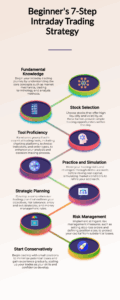
🧠 What is Intraday Trading for Beginner?
Intraday Trading for Beginner is a popular method of trading where you buy and sell stocks on the same day, aiming to capitalize on small price fluctuations. Unlike long-term investments, intraday trading requires quick decision-making, real-time analysis, and an understanding of market behavior throughout the day.
For beginners, entering the world of intraday trading can be overwhelming, but with the right strategies, tools, and mindset, it becomes manageable and highly profitable.
In this guide, we’ll walk you through everything you need to know to start your intraday trading journey with confidence and avoid common pitfalls that can lead to losses.
🎯 Who Should Learn Intraday Trading for Beginner?
If you are someone who:
- Wants to make quick profits from stock market movements
- Can dedicate time to monitor the market
- Has a keen interest in understanding stock trends
- Wants to pursue trading as a full-time career or a side hustle
Then, Intraday Trading for Beginner might be the right fit for you. With structured learning, you can become proficient and consistent, even if you have no prior experience in trading.
🔑 Why Learn Intraday Trading?
Intraday trading offers several key benefits:
- Low capital requirement: You don’t need a huge amount of capital to start trading intraday.
- No overnight risk: Intraday traders do not carry positions overnight, which eliminates the risks associated with after-market price changes.
- Potential for high profits: Small price movements throughout the day can lead to substantial profits if traded correctly.
- Active learning: Continuous exposure to live market conditions allows you to learn quickly through experience.
🛠️ Essentials to Start Intraday Trading for Beginner
Before jumping into the markets, make sure you have these essentials ready:
✅ 1. Demat & Trading Account
To trade, you must have a demat and trading account. Choose a trusted broker like:
These platforms will help you execute trades and hold shares electronically. Ensure you open an account with low fees and good customer support.
✅ 2. Trading Platform & Tools
You’ll need an effective trading platform for real-time charting and order execution. Look for platforms that:
- Offer charting and analysis tools
- Provide fast order execution
- Offer mobile apps for trading on the go
Tools like TradingView and MetaTrader 4 can also be very useful in analyzing price charts and trends.
✅ 3. Initial Capital
While you can start with a small amount, ₹5,000 to ₹25,000 is an ideal starting point for intraday trading. Ensure you only use the money you can afford to lose while learning.
✅ 4. High-Speed Internet
A reliable internet connection is crucial. Delays in placing orders could lead to losses, especially in a fast-paced market environment.
📚 Intraday Trading for Beginner: 7-Step Guide

🔹 Step 1: Master the Basics
Before you start trading, you need to understand the fundamental concepts:
- Market Orders & Limit Orders: Know when to place a market order and when a limit order is more effective.
- Candlestick Patterns: These patterns give insights into market trends and possible price reversals.
- Support & Resistance Levels: These are key price points where stocks tend to reverse direction.
- Volume Analysis: Trading volume can indicate the strength of a price move.
Focus on these foundational concepts before proceeding to complex strategies.
🔹 Step 2: Select the Right Stocks for Intraday Trading
For beginners, choose stocks that:
- Have high liquidity
- Are part of the NIFTY 50 or BANK NIFTY indices
- Have large trading volumes, ensuring that you can enter and exit positions quickly
🔹 Step 3: Choose Simple Trading Strategies
It’s best to start intraday trading for beginner with simpler strategies and focus on mastering one or two. Here are some ideas for effective trading strategies:
📊 VWAP + RSI Strategy
- Buy Signal: When the stock price is above the VWAP (Volume Weighted Average Price) and the RSI (Relative Strength Index) is between 50 and 60.
- Sell Signal: When RSI crosses 75 or when the stock hits a resistance level.
📉 Breakout Trading Strategy
- Identify Support & Resistance: Look for stocks that are trading within a defined range and buy when the price breaks above resistance.
- Exit on Breakdown: Use stop-loss orders to minimize your risk.
🔹 Step 4: Practice Risk Management
The intraday trading for beginner involves high volatility, so managing risk is critical. Here’s how:
- Stop-Loss Orders: Never risk more than 2% of your total capital on a single trade. Use stop-loss orders to limit losses.
- Risk-to-Reward Ratio: Maintain a minimum 1:2 risk-to-reward ratio on each trade. For every ₹1 risked, aim to make ₹2 or more.
- Trading Size: Always trade with a position size that aligns with your account size and risk tolerance.
🔹 Step 5: Use Demo Accounts
Before you start trading with real money, use demo accounts to practice:
- Learn how to execute trades without financial risk
- Practice using charting and technical indicators
- Understand market trends without fear of losing money
Demo trading can help you gain the confidence to trade effectively.
🔹 Step 6: Track Your Progress with a Trading Journal
Keeping a journal of your trades can provide valuable insights. Record the following:
- Entry and exit points
- Trade reasoning (why you entered/exited)
- Results of the trade (profit or loss)
- Emotional response during the trade
This journal will help you analyze your strengths and weaknesses and refine your strategies over time.
🔹 Step 7: Learn from Experts and Mentors
The best way to improve your trading skills is by learning from those who have already mastered it. Join trading communities, attend live webinars, and seek mentorship from seasoned intraday traders.
💡 Intraday Indicators for Beginner Traders
To improve your intraday trading, it’s essential to understand and use key indicators like:
| Indicator | Purpose |
| VWAP | Identifies the average price weighted by volume, helping to determine trends. |
| RSI | Identifies overbought or oversold conditions, useful for buying/selling signals. |
| MACD | Helps detect momentum shifts and trend reversals. |
| Supertrend | Simple trend-following indicator with buy/sell signals. |
By focusing on just a few key indicators, beginners can avoid overwhelming themselves.
⚠️ Common Mistakes to Avoid in Intraday Trading for Beginner
Here are some common mistakes beginners make in intraday trading:
- Trading Without a Plan: Having no clear strategy or exit points can lead to poor decisions.
- Chasing Losses: Avoid overtrading or increasing your position size after a loss. Stick to your strategy.
- Ignoring Risk Management: Always use stop-loss orders to protect your capital.
- Following Social Media Tips: Trust your own research rather than relying on social media trading tips.
Avoiding these mistakes will help you become a more disciplined and profitable intraday trader.
🎓 Success Stories from Our Students
“I started with no prior experience, but after completing the beginner course, I’m now able to make consistent profits every week. It was worth every penny!”
— Ravi P., Pune
“I was afraid of losing money, but after learning from SEBI-certified trainers, I feel confident in my trading decisions.”
— Neha S., Mumbai
🚀 Ready to Start Intraday Trading?
The world of intraday trading for beginner is exciting, but it’s important to approach it with the right knowledge and strategies. You can start today by:
Hi, this is a comment.
To get started with moderating, editing, and deleting comments, please visit the Comments screen in the dashboard.
Commenter avatars come from Gravatar.